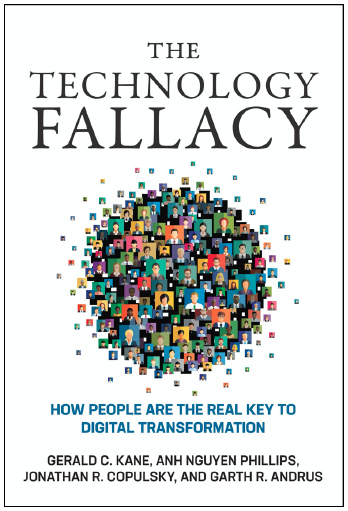INSIDER: The Technology Fallacy
Brian LeCompte, MDiv/MBA Candidate
 On August 10, 1999, Blockbuster was valued at $4.8 billion at its IPO. By September 23, 2010, Blockbuster—now $900 million in debt—filed for chapter 11 bankruptcy. In 1992, Borders went public and sales from operations reached $224.8 million. Fast-forward to February 16, 2011, and Borders was over $1 billion in debt and filed for chapter 11 bankruptcy. Technological innovation has excited people and worried others. Companies are on edge wondering when the next “digital disruption” will upset their industry and drive them to bankruptcy. Computers seem to always get smaller, cheaper, and more powerful. How can companies manage the rapid change in technology? The Technology Fallacy, authored by Gerald Kane, Anh Phillips, Jonathan Copulsky, and Garth Andrus, suggests that managing technological disruption is not about managing technology at all. It is about managing people.
On August 10, 1999, Blockbuster was valued at $4.8 billion at its IPO. By September 23, 2010, Blockbuster—now $900 million in debt—filed for chapter 11 bankruptcy. In 1992, Borders went public and sales from operations reached $224.8 million. Fast-forward to February 16, 2011, and Borders was over $1 billion in debt and filed for chapter 11 bankruptcy. Technological innovation has excited people and worried others. Companies are on edge wondering when the next “digital disruption” will upset their industry and drive them to bankruptcy. Computers seem to always get smaller, cheaper, and more powerful. How can companies manage the rapid change in technology? The Technology Fallacy, authored by Gerald Kane, Anh Phillips, Jonathan Copulsky, and Garth Andrus, suggests that managing technological disruption is not about managing technology at all. It is about managing people.
THINK POINT #1: Striving for Digital Maturity
In their research, the authors found that approximately 87% of survey respondents—taken from a 16,000-person cross-section of 20 different industries—believe that digital technologies will disrupt the industry in which they work. Only 44% believe that their organization is adequately preparing for the future. A likely explanation for this discrepancy is that executives do not know how to respond to the rapidly changing landscape. Moreover, many companies experience better digital gains in some aspects of their business than others (e.g., communication with employees vs. customers).
The authors cite Everett Rogers’ well-known research on the diffusion of innovation. Innovative changes—in this case, changes in technology—are first adopted by innovators and early adopters in society. Business’s adoption of new technology, along with its employees, signals acceptance of new technology by the majority as it is adapted to specific business applications. The final assimilation of technological innovation occurs when society implements laws and regulations that govern the proper use of and boundaries for technology.
The authors suggest that companies should strive for digital maturity, which they define as “aligning an organization’s people, culture, structure, and tasks to compete effectively by taking advantage of opportunities enabled by technological infrastructure, both inside and outside the organization.” Instead of requiring employees to reskill themselves to use the company’s new tech every six months, companies should take advantage of the fact that their employees have great consumer technologies with which they are already familiar. If managers encourage a digitally savvy culture where innovation arises organically (vs. top-down command structures) then growth happens naturally and new technologies will reveal themselves, not as threats, but as great opportunities. In other words, managers should manage people, not technology.
THINK POINT #2: Leading Toward Digital Maturity
A common temptation is to think that core principles of good leadership have changed as a result of digital disruption. This is wrong. Good leadership in today’s business environment must first consider the business value of digital initiatives the same way that businesses have always considered new initiatives. Good digital leaders form a culture that is comfortable with change by casting a vision for the organization that encourages experimentation and leadership at every level of the organization. Digital leaders are influencers, not commanders. The traditional command-structure of rigid hierarchical organizations cannot adapt to the changing digital landscape quick enough to maintain competitive advantage. The core principle of determining the business value of an initiative is still the same.
While core principles of good leadership have not changed, the leadership style necessary for good digital leadership has. In order to maintain a digitally mature culture, leaders must search for the right kind of talent. The most important talent a digitally mature workforce has is a commitment to lifelong learning. Since change happens every day in a digital landscape, employees (and leaders, for that matter) must continuously improve their knowledge and skillsets to take advantage of the new opportunities that digital innovation provides. If employees are not concerned with continuous learning, their skills may become obsolete. Successful leaders understand that the future of work is very different from the present and so encourage their employees to continue learning. Leaders can identify the kind of learning that is needed by looking for great talent in some of the least expected places. One of the fastest growing talent pools is the “gig” employee talent pool. These are freelancers who produce digital content, often on crowdsourced platforms, who can be brought in for specific projects. Remember, individuals adopt new technologies faster than companies can adapt to them, so looking to a pool of freelancers for special projects leverages those talents for your company and teaches you something about the future of the digital landscape.
THINK POINT #3: Structuring for Digital Maturity
The key attribute every company needs to be digitally mature is agility. With transformation happening so quickly, companies need to be able to change quickly across all levels of the company, as well. Companies that are not digitally mature often implement a “push” strategy. That is, top management decides on a change and pushes those changes outward. This requires a lot of effective communication and can take up too much time. Companies that are digitally mature use “pull” strategies that encourage a culture of transformative thinking. In digitally mature companies, employees are the catalyst for digital transformation.
Fostering an agile company culture requires some changes in the way businesses have been organized. Organizations reinforce siloes to their own peril. Agile organizations encourage cross-functional teams that work together to accomplish business initiatives. These organizations build project teams from multiple business units—marketing, finance, operations, etc.—that can think outside the box in which siloed business units may be stuck. Leaders in agile organizations do not need to control every decision. Instead, they should invest these teams with decision-making power, so those teams are incentivized to produce quality results. Moreover, good digital leaders will often place some freelancers on the cross-functional teams within their organizations to broaden the perspectives of the teams. By tapping into these talent pools, organizations improve their ability to adapt to changes in the digital landscape.
 Digital leaders set up these cross-functional teams for success with tools that encourage collaboration and with an understanding that failure will sometimes happen. Agile organizations communicate quickly and adapt project workflow quickly. One of the best ways to encourage collaboration is equipping employees with digital platforms, such as social media, that allow digital content to be shared and explored on demand. This rapid communication encourages innovation. Efficient innovation is a core competency of a digitally mature organization. In the past, many organizations sought to make their business processes as efficient and error-free as possible. Failure was not an option, because it created extra costs. In today’s digital landscape, companies need cross-functional teams that are always innovating to keep up with the rate of change. This means that sometimes failure occurs. The authors do not suggest that failure should always be tolerated—only expected occasionally. The important thing is that companies experiment fast, learn fast, and scale fast.
Digital leaders set up these cross-functional teams for success with tools that encourage collaboration and with an understanding that failure will sometimes happen. Agile organizations communicate quickly and adapt project workflow quickly. One of the best ways to encourage collaboration is equipping employees with digital platforms, such as social media, that allow digital content to be shared and explored on demand. This rapid communication encourages innovation. Efficient innovation is a core competency of a digitally mature organization. In the past, many organizations sought to make their business processes as efficient and error-free as possible. Failure was not an option, because it created extra costs. In today’s digital landscape, companies need cross-functional teams that are always innovating to keep up with the rate of change. This means that sometimes failure occurs. The authors do not suggest that failure should always be tolerated—only expected occasionally. The important thing is that companies experiment fast, learn fast, and scale fast.
Conclusion
Becoming a digitally mature organization is a change in mindset. It will not happen in a day. Organizations can only identify a few areas at a time that can grow. Therefore, it is critical to periodically assess the current situation by consulting multiple sources like employees, talent pools, and other digitally mature companies. Organizations will have to be intentional about creating cross-functional teams that seek solutions for those few areas that have the best potential for growth. For real estate, this may mean that firms learn from the success they have with digital initiatives for employee and partner collaboration, then assign a cross-functional team with the task of leading the organization to the same level of digital maturity with customer communications. Leadership needs to inspire employees to take ownership of their organization’s digital abilities. After all, managing digital transformation is really about managing people.
. . . . . . . . . . . . . . . . . . .
Recommended Reading
Kane, Gerald C., Anh Nguyen Phillips, Jonathan R. Copulsky, and Garth R. Andrus (2019), The Technology Fallacy: How People are the Real Key to Digital Transformation, MIT Press: London, England.
. . . . . . . . . . . . . . . . . . .
About the Author
Brian LeCompte, MDiv/MBA Candidate
Baylor University
Brian LeCompte is a graduate student from Conyers, Georgia. He earned his Bachelor of Arts in Biblical Studies and his Master of Arts in Theological studies from Criswell College. He has previously worked as a universal banker with BBVA Bank while simultaneously serving as a Baptist minister in Central Texas. Brian is pursuing a joint MDiv/MBA degree and is seeking a career as a bivocational pastor working full-time in the financial services industry and serving part-time on staff at a local church.